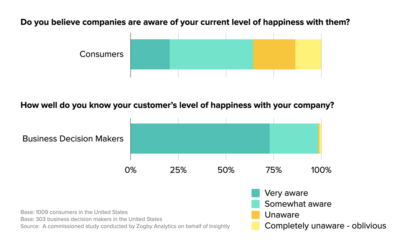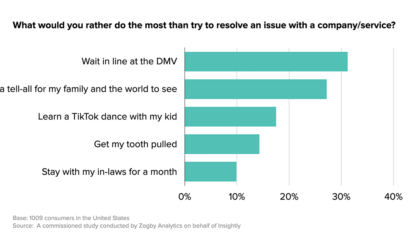Last week I did a webinar with the fine folks at the Society of Digital Agencies about the disconnect among brand, marketing, and customer experience (CX) that exists in many organizations. My advice to the attendees, who were (unsurprisingly) mostly from digital agencies, was to strive to connect the marketing promises that they create with the reality of their clients’ current customer interactions.
I got a lot of great questions from the attendees, but didn’t have time to answer them all on the webinar — so I thought I’d answer them here.
What are the operational obstacles (client-side and agency-side) that preclude a stronger approach to customer experience? How have you overcome them?
On the client side, traditional silos and a lack of cross-silo communication prevent the marketing folks from talking with customer service, operations, IT, finance, etc. on a regular basis (or, sometimes, at all). The result is that the people who are responsible for making promises to customers aren’t collaborating with the people who are responsible for keeping those promises. Organizations need to find a way to create a holistic view of customers and what customers experience as their interactions cross organizational boundaries.
One big problem on the agency side is that the approach embodied by Don Draper in the 1960’s — treating clients with kid gloves and treating agency work as a black box — is still dominant today. The approach that I suggest (connecting marketing promises to CX reality) is only going to work if clients are embedded in agency processes and can help to both communicate their CX bright spots and co-create marketing communications that reflect the true culture and capabilities of their organizations.
One of the key issues in many organizations is the lack of vision for a unified customer experience. Each unit is focused on their value proposition to the customer, but these silos prevent holistic approach and superior customer experience. What are the key steps to get out of this pattern?
I strongly suggest that companies embark on a journey mapping initiative. Journey maps are illustrations of the steps that customers go through as they do business with a company, the touchpoints they interact with, and their thoughts and emotions along the way. They’re effective at creating a unified vision because real customer journeys naturally cross many organizational silos as customers shop for, buy, and use a company’s products and services. But keep in mind that the journey map itself isn’t your end goal — what you’re after are the insights and collaboration that result from the process of journey mapping. That’s why I always suggest that companies start this activity in a workshop setting with cross-functional teams.
Service blueprints are also effective tools. They’re similar to journey maps, but in addition to looking at what’s going on from the customer perspective, they detail all of the people, processes, and technologies that enable that experience from behind the scenes. Identifying these often hidden drivers is a critical step in fixing the root causes of customer issues.
If marketing is a systems approach, how does that tie into the overall concept of still needing to sell an idea to the client?
Aligning marketing communications with customer experience doesn’t necessitate the end of the big idea. Apple’s brilliant Mac vs PC campaign was one of the most memorable examples of this approach in recent years, and Apple’s commercials showcasing the interface and utility of the iPhone and iPad created an entire genre of ads that’s now been copied by other consumer electronics companies.
One of my favorite campaigns from recent years is JetBlue’s Taken For A Ride series, in which the airline made fun of its competitors’ baggage fees, lack of legroom, and less-than-desirable snacks by playing out ridiculous (but analogous) scenarios with unsuspecting New York City citizens and tourists.
So don’t give up on the big idea. Just make sure it’s rooted in the reality of the customer experience.
If we better integrated communication strategy with product and experience design and innovation, could we start addressing this issue more fundamentally in the future?
That’s my belief and my hope. 🙂
What methods do you employ to measure the effectiveness of good digital customer experience (and it’s relationship to brand)?
There are so many ways to measure digital experiences. Analytics, A/B and multivariate testing, usability testing, and surveys are just a few.
Getting specifically at the effectiveness of digital experiences within the context of the brand is a bit more subjective. You first want to look for consistency with basic stuff like brand colors, imagery, and typography — you don’t want someone seeing a billboard or a print ad and then downloading an app that makes them wonder if it’s from the same company.
But brand personalities can be pretty subtle, and again you need to think about what expectations you’re setting for other channels and touchpoints. If, say, Amazon had 1-click checkout on its site but then took three weeks to deliver the items we purchased, we’d probably be pretty confused about what its brand really stands for.
Keep in mind that this is a two-way street. The brand should influence digital (and non-digital) touchpoints, but those touchpoints also continue to evolve customers’ perceptions of the brand.
How can we encourage clients to consider the digital sphere when creating a brand and ensuring the creative design takes into consideration the full suite of platforms — print and digital? What advice would you give to an agency that’s negotiating a website build with a client who has an existing relationship with a traditional advertising agency responsible for all creative?
The answers to these two questions are related.
I first experienced misunderstandings about what works for digital (and what doesn’t) when I worked at a dotcom in 1999, and it’s unfortunate that we’re still dealing with these issues today. But the technology behind digital channels has changed dramatically since the early days of the Web — and it will continue to do so far into the future. That’s just how technology goes. So we’re always going to be in a situation of having to explain, “What worked before just doesn’t work now. We have to do things differently.”
I think the only real answer to this is that agencies have to invest in ongoing client (and prospective client) education. That means short and easy-to-read whitepapers explaining today’s design and tech considerations, case studies about clients that have successfully made the transition, straight forward slide decks that show best practices from leading digital sites/apps, and probably many more Come-to-Jesus conversations than you’d like to have.
As I mentioned above, I’m also a fan of co-creation. If the client feels that they’re part of the decision to move in a particular direction — rather than having something forced upon them — they’ll be much more supportive of whatever’s required (like time and fees) to make it happen.
I hope these answers are helpful! Please watch for more posts on these topics in the future.




